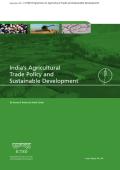Could trade policy measures enable a rapid dissemination of sustainable energy goods and services, given the reality of the widespread use of both fossil-fuel subsidies as well as clean-energy incentives? With the help of a computable general equilibrium modelling exercise, this paper attempts to show what happens to a number of economic and environmental variables such as exports and imports, carbon emissions, energy and electricity prices, employment generation and income, when import tariffs as well as local content measures (LCRS) for renewable energy equipment are removed under different scenarios. A similar exercise is conducted for ethanol involving the removal of import tariffs with and without removing ethanol subsidies.
Regional Trade Agreements (RTAs) are increasingly used for addressing sustainable development goals by including provisions on climate change and sustainable energy. This paper examines that trend and presents an overview of different categories of such provisions in a broad sample of recent RTAs, identifying current regulatory challenges and highlighting obstacles in addressing climate change. It appeals to the necessity of securing flexibility for regulators in targeting new climate threats and the need for cooperation to implement international and national objectives in the efforts to enhance low-carbon technologies. After a preliminary assessment of the potential legal effects of the provisions, the authors make recommendations intended to optimize the potential of promoting the development of a sustainable low-carbon economy through trade agreements.

This chapter in Ensuring Good Global Governance through Trade presents an analysis of sustainable development goals in the context of two mega-regional trade agreements: the Transatlantic Trade and Investment Partnership (TTIP) and the Trans-Pacific Partnership (TPP). These preferential trade agreements present a more efficient vehicle by which to promote sustainable development than the multilateral trading platform. The chapter discusses sustainable development and energy within the proposed TTIP. The TTIP aims to further economic growth, investment and trade between the United States and the European Union (EU), and could potentially have a very large impact as the U.S.-EU trade and investment flows are sizeable and a critical element in global commerce. The chapter argues that the TTIP has the potential to foster sustainable development, energy efficiency, and energy security.
This paper explores the relative average GHG intensity of production of selected goods in different world regions and the potential for regions to access low-GHG fuels and feedstocks needed to expand low-GHG production. While a complete analysis of shifting trade patterns would assess the economic implications, including the scale effect, the authors present a simplified approach which allows them to gauge what conditions might enable countries to be future low-GHG producers.
They begin by looking at the emissions embodied in trade (Section 2), based on a multiregional input-output model, to help identify significant trade flows for further analysis. Section 3 then examines differences in GHG-intensity among regions for some of the categories identified, while Section 4 asks whether and how shifting the location of steel production could reduce global GHGs. Section 5 assesses a range of national and international policies that could be used to shift trade patterns. Section 6 summarizes the results and identifies areas for further research.
